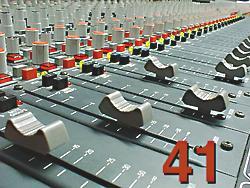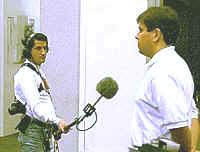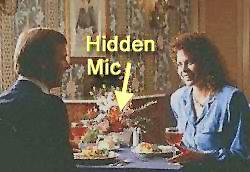|
Module 41 |
Updated: 07/07/2005 |
|
Using Off-Camera
|
|
Room Acoustics Whenever a room has smooth, unbroken walls or uncarpeted floors, reverberation (slight echoes) can be a problem. Moving mics closer to subjects is the simplest solution, but this is not always possible. Other solutions include using highly directional mics, adding sound absorbing materials to walls, or placing objects within a scene that will absorb or break up sound reflections. As we previously noted, one type of highly directional mic commonly used for on-location shoots is -
As with all directional mics, they have to be carefully aimed, preferably with the aid of high-quality earphones. Shotgun mics are often mounted on -
The quickest solution for
picking up audio, especially in As the name suggests, a fishpole consists of a pole with a mic attached to one end. The position shown here allows good audio pickup, while the camera (out of range on the left), holds a closeup of the talent. An operator equipped with an audio
headset to monitor the sound being picked up can move the microphone according to
changes in camera shots and talent position. Supercardioid and hypercardioid mics
mounted in a shock mount (a rubber cradle suspension device)
are commonly used. Microphone Booms
In the studio the simple fishpole moves into the much more sophisticated category of boom mics. Microphone booms range from a small giraffe (basically a fishpole mounted on a tripod) to a large perambulator boom (that weighs several hundred pounds, takes two people to operate, and can extend the mic over the set from a distance of 100 meters (more than 30 feet). The largest booms have a hydraulically controlled central platform where operators sit and watch the scene on a TV monitor while controlling such things as the
Hanging Microphones Sometimes you can get by without a boom mic, especially if the talent is confined to a limited area. In this case a mic can be suspended over a performance area by tying it to a grid pipe or fixture just above the top of the widest camera shot. The disadvantage of this approach, of course, is that the mic can't be moved during the production. Both boom mics and suspended microphones should be checked with
the studio lights turned on to make sure they do not create shadows on backgrounds
or sets. Hidden Microphones It's sometimes possible
to hide microphones close to where the Microphones are sometimes taped to the back of a prop or even hidden in a table decoration, such as the vase of flowers shown here. When placing mics, keep in mind the proximity effect discussed in an earlier module. You may find during an editing session that the audio from different mics used at different distances will not "cut together" without annoying changes in quality. Sometimes several mics
must be used on a set at the same time. In this case each mic not being used at
a particular moment should be turned down or switched off. This not only reduces
total ambient sound, but also eliminates something called - Phase Cancellation Phase cancellation, which results in low-level and hollow-sounding audio, occurs when two or more mics pick up sound from the same audio source. Because the sounds arrive at the mic at slightly different times, they end up being out of phase and to various degrees cancel each other out. When multiple mics are used on a set there are four things you can do to reduce or eliminate the resulting phase cancellation:
In the next section we'll explore another dimension of audio: stereo and surround-sound. |

 Because of their highly directional characteristics
shotgun mics can be used out of camera range at distances
of up to 10 meters (25 to 30 feet).
Because of their highly directional characteristics
shotgun mics can be used out of camera range at distances
of up to 10 meters (25 to 30 feet). on-location shooting, is to attach a directional mic to a pole and have someone
hold it just out of camera range.
on-location shooting, is to attach a directional mic to a pole and have someone
hold it just out of camera range.
 on-camera talent will be seated or standing. This will eliminate both the need for
personal or handheld mics and the problems that mic cords can introduce.
on-camera talent will be seated or standing. This will eliminate both the need for
personal or handheld mics and the problems that mic cords can introduce.